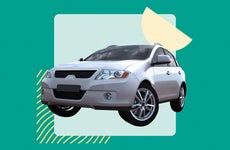How to get out of an auto loan or lease

The Bankrate promise
At Bankrate we strive to help you make smarter financial decisions. While we adhere to strict , this post may contain references to products from our partners. Here's an explanation for .
Key takeaways
- You can renegotiate, refinance or sell your vehicle to get out of a car loan you can’t afford.
- Refinancing can be a good option if your credit score has improved since you initially took out the loan.
- When trying to exit a lease early, be aware of potential fees and consider transferring the lease to someone else.
An auto loan or lease is a great way to get behind the wheel without emptying your savings. But if you can no longer afford your monthly payments or are on the verge of becoming upside down on your loan, there are ways out.
If you bought your vehicle, you could renegotiate or refinance your loan or sell the car. You may be able to transfer a lease to someone else or pony up a fee to exit it early.
How to get out of a car loan you can’t afford
There are a few ways you can exit if the loan no longer fits your budget. But you’ll need to tread carefully if you want to minimize the hits to your wallet and your credit rating.
1. Renegotiate the loan
Best for borrowers who are on the brink of becoming delinquent on their auto loan — especially if they are on otherwise good terms with their lender.
You can contact your lender to negotiate a new payment plan and request a car loan modification. This is an especially good option if you have good credit and payment histories and only need temporary assistance to catch up.
If you hope to renegotiate, it’s best to reach out to the lender before you fall behind on payments. Lenders are more likely to renegotiate with a customer with a history of making payments as required.
When contacting your lender, have a plan in mind to resolve the situation you can share. Know how large a payment you can afford as part of a renegotiated loan.
It is also possible to give yourself some extra time by deferring payments or even stretching out your loan term — but keep in mind the longer the term, the more interest there will be overall. Before arranging to meet with your lender, take a close look at your finances and estimate what kind of monthly payment you can stick to for the remaining duration of your loan.
2. Sell the vehicle
Best for borrowers who can turn a profit on their current vehicle and get a cheaper replacement.
Another strategy is to sell the car with the lien. Because you don’t own the car outright, you need to get permission from your lender first:
- Contact the lender.
- Let a representative know you are interested in selling the car.
- Ask about the transfer process and paperwork, including the credit application a potential new owner would need to fill out.
Trading in your car at a dealership is similar to selling. But it may be a simpler process than going through a private sale. However, you may not receive as much for your vehicle from a dealer.
You may also be able to sell to a friend or family member if that’s something you are interested in — and the lender approves. But you are still on the hook for any remaining balance on the auto loan.
Avoid putting yourself in another precarious financial situation by having to dip into your retirement or other savings in order to pay off the vehicle.
3. Voluntary repossession
Best for those who cannot afford their vehicle and have exhausted other options.
You should consider turning your car over to your lender as your absolute last resort. To make this process more bearable, ask your lender if turning over your car voluntarily will clear you of your loan obligation.
By turning in the car, you save your lender the cost and hassle of repossession. You may be able to strike a more favorable final pay-off amount. It may free you of some final costs, including late or prepayment fees or fees tied to the vehicle’s resale.
But this route will mean a hit to your credit score and could make auto financing more difficult in the future. A voluntary repossession will stay on your credit report for as long as seven years.
What to do if your lender won’t repossess your car
Opting for this route doesn’t always go smoothly. Sometimes, the lender does not respond immediately. In those cases, you have options:
- Keep the vehicle and continue to use it: One day, the lender or some collection agency may determine it is worthwhile to pick up the vehicle. Until that happens, keep the vehicle registered and maintain proper insurance.
- Park the vehicle and mail in the keys: Park the car in a public location and send the creditor a copy of the keys via registered mail. Make sure it is parked in a location where a tow truck can legally access and repossess it. The main risk here is that you must confirm that the proper entity, rather than a car thief, picked up the car.
- Keep contacting the lender: This will take a lot of persistence, but eventually, it should get the lender to act. You can try to get the lender’s mailing address. Then, you can mail a formal demand letter notifying them that their vehicle sits waiting to be picked up.
4. Refinance your loan
Best for those who can qualify for a more affordable auto loan payment by refinancing thanks to an improved credit score or other circumstances.
Refinancing your loan will help you save money month to month, in the long term or both.
- A lower interest rate can decrease your monthly payment and overall interest paid. However, this can be difficult to do if you’re already behind on payments or don’t have great credit.
- A longer repayment term can decrease your monthly payments but also increase the overall interest paid.
Refinancing is a good option if your credit score has improved since you initially signed off on your loan agreement. A better credit score means you can likely qualify for lower interest rates and more favorable terms.
But be on the lookout for fees. A common one is an early repayment penalty, which is exactly what it sounds like: a fee for paying off the loan early.
5. Pay off the car loan
Best for those who have room in their budget to make loan payoff a reality.
If you are struggling to meet your monthly payments, paying off your loan entirely may not be possible. But if you have the financial backing to pay it off early, you can walk away and get rid of the financial stress.
One way to pay off your loan is to pay one large lump sum. Before going ahead with this route, be sure to confirm with your lender the amount owed. It will most likely be a combination of your loan balance and interest fees.
Another, potentially more doable option is raising your monthly payment slightly so that payoff happens earlier. Managing your car loan this way means paying less interest overall.
Exiting a lease
Because you don’t own the car, you have far fewer options if you are looking to end your lease early. There are ways out — but they may be costly.
Transfer the lease
You can transfer your lease to someone else. Websites such as Swapalease, LeaseTrader and LeaseQuit help current lessees connect with drivers willing to take over their leases. Fees vary, so shop carefully. You may have to pay for your own credit check and to ship your car to its new lessee.
Early termination
Your lease likely includes the option to end it early. This is often expensive and should be a last resort.
Your car lease should spell out the costs of ending your lease early, but you can also ask your leasing company directly. Most leasing companies charge an early lease termination fee, typically the difference between what you currently owe and the car’s estimated lease-end value. This can total hundreds of dollars.
You’ll also pay standard end-of-lease fees, like disposition fees and potential excess mileage charges.
The bottom line
It is never too late to walk away from a loan or auto lease if you can no longer afford it. Take the time to understand all of your options and choose what is best for you based on your financial situation. And ahead of your next vehicle purchase, be sure to compare auto loan rates to ensure you are buying a car that you can afford over the long term.
Related Articles



